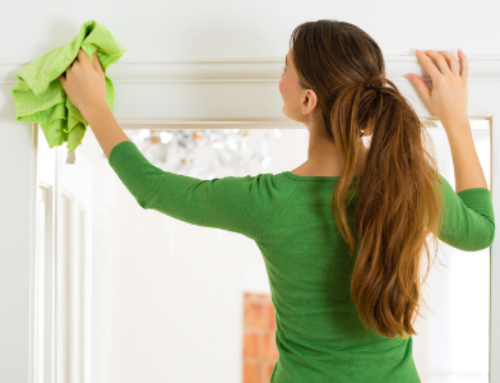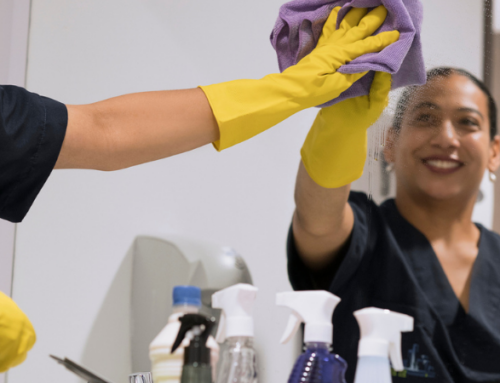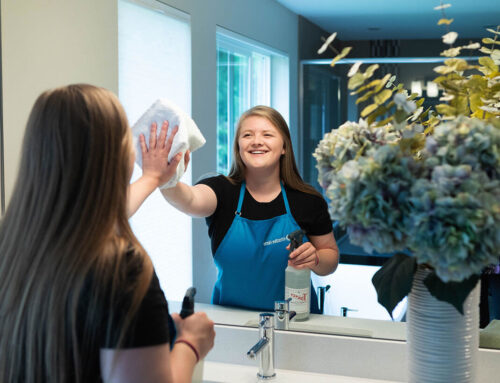Cold and flu season is upon us, and with it comes the heightened risk of illnesses caused by germs and viruses. In this comprehensive guide, we will delve into “The Science of Disinfection: Keeping Your Home Germ-Free During Cold and Flu Season.” We’ll explore the strategies and techniques that can help you maintain a healthy and clean living space when these illnesses are most prevalent.
Let’s uncover the science of disinfection and discover how you can protect yourself and your loved ones during the cold and flu season.
The Importance of Disinfection in Cold and Flu Season
Cold and flu season presents unique challenges when it comes to maintaining a germ-free home. Here, we’ll discuss why it’s crucial to focus on disinfection during this season.
- Understanding Seasonal Viruses: As the temperature drops, viruses like the flu become more active and easily spread from person to person.
- Reducing the Spread of Illness: Cold and flu illnesses can be severe and debilitating. Disinfection is key to minimizing the risk of falling ill and spreading the viruses.
- Ensuring a Healthy Environment: A clean and germ-free home not only keeps you healthy but also provides a sense of well-being during the cold and flu season.
The Science of Effective Disinfection
In the ongoing battle against germs and viruses, especially during the cold and flu season, understanding the science of effective disinfection is crucial. Let’s explore this topic further and break it down into key components that will empower you to keep your home germ-free.
Types of Disinfectants
When it comes to disinfecting your living space during cold and flu season, not all disinfectants are created equal. There are various types of disinfectants available, each with its specific applications and advantages.
- Alcohol-Based Disinfectants: These are effective against a wide range of germs and viruses. They’re commonly found in hand sanitizers and surface disinfectant sprays. Alcohol-based disinfectants work by denaturing the proteins in the pathogens, rendering them inactive.
- Quaternary Ammonium Compounds (Quats): Quats are frequently used in household disinfectants. They are safe for most surfaces and effectively kill bacteria, fungi, and some viruses by disrupting their cell membranes.
- Hydrogen Peroxide: Hydrogen peroxide is a versatile disinfectant. It can kill bacteria, viruses, and mold spores. When it breaks down, it releases oxygen, which helps in the disinfection process.
- Chlorine-Based Disinfectants: Chlorine-based disinfectants, like bleach, are powerful germ fighters. They work by oxidizing and breaking down the cellular structures of pathogens.
- Natural Disinfectants: Some natural alternatives like vinegar, baking soda, and essential oils can also be effective against certain germs. While they may not be as potent as chemical disinfectants, they offer a more environmentally friendly option.
It’s important to choose the right disinfectant based on the surfaces you intend to clean and the specific germs or viruses you want to target. For example, use alcohol-based sanitizers for your hands but opt for chlorine-based disinfectants for bathroom surfaces to combat mold and mildew.
Mechanisms of Disinfection
To grasp the effectiveness of disinfectants, it’s essential to understand how they work at the molecular level to eliminate germs and viruses.
- Denaturation: Many disinfectants, such as alcohol-based ones, denature the proteins in pathogens. This means they alter the proteins’ structure, rendering them non-functional. When proteins in germs lose their shape, they can no longer carry out vital functions, effectively neutralizing the threat.
- Oxidation: Chlorine-based disinfectants work by oxidizing the cellular components of germs. Oxidation reactions release oxygen, which disrupts the cellular structures and metabolic processes of pathogens, leading to their destruction.
- Cell Membrane Disruption: Quaternary ammonium compounds (Quats) act by disrupting the cell membranes of bacteria and viruses. This disruption causes the pathogens’ contents to leak out, ultimately leading to their demise.
Choosing the Right Disinfectant
Selecting the most suitable disinfectant for different surfaces and areas in your home during cold and flu season is crucial for effective germ control. Here are some tips to help you make the right choice:
- Consider Surface Material: Take into account the material of the surface you’re disinfecting. Some disinfectants may damage certain materials, so always check the manufacturer’s guidelines.
- Targeted Pathogens: Identify the specific germs or viruses you want to eliminate. Some disinfectants are better at targeting certain pathogens than others.
- Contact Time: Read the label to understand how long the disinfectant needs to remain on the surface to be effective. Some require a longer contact time than others.
- Safety Precautions: Be aware of any safety precautions or ventilation requirements when using disinfectants. Some may require protective gear or adequate ventilation.
- Environmental Impact: Consider the environmental impact of the disinfectant you choose. Some eco-friendly options are gentler on the planet.
For instance, if you’re disinfecting kitchen countertops where you prepare food, you might opt for a natural disinfectant like vinegar or a food-safe sanitizer. However, in the bathroom, where mold and mildew are common issues, a chlorine-based disinfectant could be more appropriate.
Understanding the science of disinfection and selecting the right disinfectant for the job are essential steps in keeping your home germ-free during the challenging cold and flu season. Armed with this knowledge, you can create a healthier living environment for yourself and your family.
When cold and flu season arrives, it’s time to pay extra attention to specific areas of your home to minimize the risk of germ transmission. Let’s delve into these key areas and understand why they require extra care during this season.
Kitchen Hygiene
Your kitchen is the heart of your home, and during cold and flu season, it can also be a breeding ground for germs. Here’s why maintaining kitchen hygiene is crucial:
Food Preparation: Cold and flu viruses can be easily transferred through contaminated food. Proper kitchen hygiene, including washing hands and disinfecting surfaces, is essential to prevent foodborne illnesses.
High-Touch Surfaces: Countertops, cutting boards, and kitchen utensils are frequently touched surfaces where germs can linger. Regular disinfection of these surfaces can significantly reduce the risk of cross-contamination.
Refrigerator and Pantry: Germs can find their way into your refrigerator and pantry, potentially contaminating your food. Regularly clean and disinfect these areas to keep your food supply safe.
Bathroom Cleanliness
Moist environments like bathrooms provide an ideal breeding ground for bacteria and viruses. Here’s why maintaining bathroom cleanliness is imperative:
Mold and Mildew: Bathrooms are susceptible to mold and mildew growth, which can exacerbate respiratory issues. Regular cleaning and disinfection help combat these allergens.
High Humidity: Bathrooms often have higher humidity levels, which can support the survival of germs. Proper ventilation and disinfection can reduce this risk.
Personal Hygiene: Frequent handwashing and face washing in the bathroom make it crucial to keep this area germ-free to prevent the spread of cold and flu viruses.
Bedroom Wellness
Your bedroom is your sanctuary, especially when you’re feeling under the weather. Ensuring bedroom wellness is vital for restful sleep and recovery:
Rest and Recovery: Adequate sleep is essential for a strong immune system. A clean and germ-free bedroom promotes better sleep and faster recovery from illnesses.
Bed Linens: Regularly wash your bed linens, including sheets, pillowcases, and blankets, to eliminate any germs that may have accumulated.
Personal Items: Items like phones, remote controls, and books that you use in bed can harbor germs. Disinfect these items to reduce the risk of germ transmission.
Living Room Germ Control
The living room is often the gathering place for family and friends, making it essential to practice germ control in this area:
Social Gatherings: During cold and flu season, social gatherings can become opportunities for germ transmission. Encourage handwashing and disinfect commonly touched surfaces before and after gatherings.
Remote Controls: Remote controls, gaming controllers, and shared devices in the living room can harbor germs. Regularly disinfect these items to prevent the spread of illnesses.
Carpet and Upholstery: Carpets and upholstered furniture can trap allergens and germs. Vacuum and clean these surfaces to maintain a healthier living space.
Home Office Health
Remote work has become the norm, and your home office plays a crucial role in your daily routine. Here’s why maintaining home office health is essential:
Productivity: A clean and organized workspace enhances productivity, especially when you’re working from home.
Shared Spaces: If multiple family members use the home office, it’s essential to disinfect shared equipment like computers and keyboards regularly.
Reduced Sick Days: A virus-free home office can help reduce sick days and ensure you stay on top of your work responsibilities.
Entryway Defense
Your home’s entryway is the first line of defense against cold and flu germs entering your home. Here’s why entryway defense is vital:
Outside Contaminants: Germs from the outside world can be carried into your home through shoes and clothing. Implement strategies like shoe removal and coat storage to reduce contamination.
Hand Hygiene: Place hand sanitizers or disinfectant wipes near the entryway to encourage hand hygiene as soon as you enter your home.
Regular Cleaning: Frequently clean and disinfect doorknobs, light switches, and the area around the entryway to minimize the risk of germs spreading throughout your home.
By paying extra attention to these key areas for disinfection during cold and flu season, you can create a healthier and safer living environment for yourself and your loved ones. These efforts, combined with proper hand hygiene and overall cleanliness, can significantly reduce the risk of illness during this challenging time of year.
Cold and Flu Season Disinfection Techniques
As we navigate the cold and flu season, it’s essential to equip ourselves with practical disinfection techniques that can help protect our homes and loved ones from germs and viruses. Here, we’ll explore these techniques in detail to ensure a healthier living environment.
Regular Cleaning Routine
Establishing a systematic cleaning routine is the foundation of effective disinfection during the cold and flu season. Here’s why it’s crucial:
High-Touch Surfaces: Identify high-touch surfaces in your home, such as doorknobs, light switches, countertops, and faucets. These areas are prone to germ buildup.
Frequently Used Areas: Focus on cleaning areas that family members frequent daily. This includes the kitchen, bathrooms, and living spaces. Regular cleaning here minimizes the risk of germ transmission.
Consistency is Key: Stick to a consistent cleaning schedule. Daily wipe-downs of high-touch surfaces and weekly deep cleaning can make a significant difference in reducing the presence of cold and flu germs.
Use the Right Cleaning Products: Choose disinfectants that are effective against the viruses and bacteria you’re targeting. Look for products with labels that specifically mention their efficacy against cold and flu viruses.
Proper Hand Hygiene
Hand hygiene is a critical component of preventing the spread of cold and flu viruses. Here’s why it matters:
Germ Transfer: We often touch our faces without realizing it, which can lead to germ transfer from contaminated surfaces to our eyes, nose, and mouth.
Handwashing: Frequent handwashing with soap and water for at least 20 seconds is one of the most effective ways to remove germs from your hands. Teach this practice to everyone in your household.
Hand Sanitizers: Hand sanitizers with at least 60% alcohol content are a convenient option when soap and water are not readily available. Keep hand sanitizers strategically placed in your home, especially near entryways.
Consistency: Encourage everyone to practice proper hand hygiene consistently, especially after coughing, sneezing, or touching common surfaces.
Ventilation and Humidity
Proper ventilation and humidity levels in your home can influence the survival of cold and flu germs. Here’s how:
Ventilation: Adequate ventilation helps disperse indoor air, reducing the concentration of germs. Open windows and use exhaust fans to promote air circulation.
Humidity: Maintaining indoor humidity levels between 30-50% can deter the survival of some viruses. Humidifiers can be beneficial in achieving and maintaining these levels.
Dehumidification: In areas with excessive humidity, consider using a dehumidifier to prevent mold growth, which can exacerbate respiratory issues during cold and flu season.
Germ-Resistant Materials
Exploring materials and fabrics that resist the buildup of cold and flu germs can be a proactive approach to maintaining a healthy home:
Antimicrobial Surfaces: Some surfaces and materials are treated with antimicrobial agents that inhibit the growth of germs. Consider using these materials in high-traffic areas.
Easy-to-Clean Fabrics: Opt for upholstery and fabrics that are easy to clean and disinfect. This is particularly important for items like couches, chairs, and curtains.
Regular Maintenance: Even germ-resistant materials require regular cleaning to remain effective. Follow the manufacturer’s cleaning instructions to maintain their germ-fighting properties.
Seasonal Allergen Control
During the cold and flu season, managing indoor allergens is crucial, as they can exacerbate respiratory issues. Here’s how to maintain control:
Dust and Vacuum: Regularly dust and vacuum your home to remove allergens like dust mites, pet dander, and pollen. Use a vacuum cleaner with a HEPA filter to capture small particles.
Wash Bedding: Wash bedding, including sheets, pillowcases, and comforters, regularly in hot water to eliminate allergens.
Air Purifiers: Consider using air purifiers with HEPA filters to reduce allergen levels in your home, promoting better respiratory health during cold and flu season.
By implementing these practical disinfection techniques during the cold and flu season, you can create a healthier and safer living environment for you and your family. These strategies, combined with regular cleaning, proper hand hygiene, and attention to indoor air quality, will help minimize the risk of illnesses and promote well-being throughout the season.
In conclusion, disinfection is a crucial aspect of maintaining a healthy lifestyle when these illnesses are prevalent. By understanding the science behind disinfection, focusing on key areas, and implementing effective techniques, you can create a safe and germ-free environment for you and your family during cold and flu season.
As the season approaches, remember that knowledge and proactive measures are your best allies against cold and flu germs. Stay informed, stay clean, and stay healthy!





